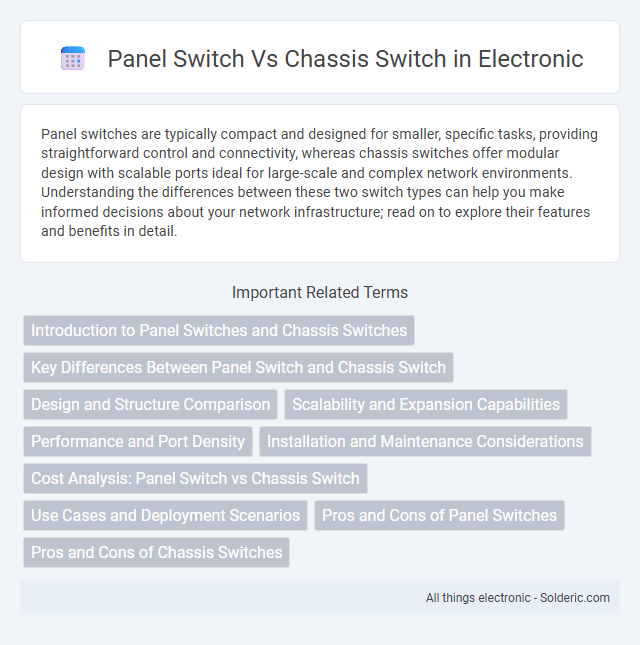Panel switches are typically compact and designed for smaller, specific tasks, providing straightforward control and connectivity, whereas chassis switches offer modular design with scalable ports ideal for large-scale and complex network environments. Understanding the differences between these two switch types can help you make informed decisions about your network infrastructure; read on to explore their features and benefits in detail.
Comparison Table
| Feature | Panel Switch | Chassis Switch |
|---|---|---|
| Design | Fixed, single unit with integrated ports | Modular, allows multiple line cards and modules |
| Scalability | Limited scalability; fixed number of ports | Highly scalable; add or replace modules for expansion |
| Port Density | Lower port density, static configuration | High port density with flexible module options |
| Performance | Suitable for small to medium networks | High performance, ideal for large enterprise or data center networks |
| Management | Simpler, basic management features | Advanced management and redundancy capabilities |
| Cost | Lower initial cost | Higher upfront cost, but cost-effective for large scale |
| Redundancy | Limited or no redundancy options | Supports power and supervisor redundancy |
| Use Case | Small offices, simple networks | Enterprise, data centers, and high-performance network environments |
Introduction to Panel Switches and Chassis Switches
Panel switches are compact, fixed-configuration devices designed for specific networking tasks with limited port capacity, ideal for small to medium setups. Chassis switches offer modular architecture with slots for line cards, enabling scalability, higher port density, and enhanced performance suitable for large enterprise networks. Your choice between panel and chassis switches depends on factors like network size, scalability needs, and budget constraints.
Key Differences Between Panel Switch and Chassis Switch
Panel switches are typically compact, modular devices with fixed port configurations ideal for smaller networks or specific applications, while chassis switches offer scalable, high-density frameworks with multiple slots for line cards, suited for large enterprise environments. The main differences lie in scalability, with chassis switches supporting extensive expansion and redundancy, whereas panel switches prioritize simplicity and lower cost. Your choice depends on network size, required throughput, and flexibility needs.
Design and Structure Comparison
Panel switches feature a modular design with individual ports mounted on panels, allowing for flexible configurations and easy upgrades in network setups. Chassis switches consist of a central frame housing multiple interconnected modules, providing high scalability and centralized management for enterprise networks. Your choice depends on desired network density, scalability, and maintenance preferences, as chassis switches typically support higher port density and redundancy than panel switches.
Scalability and Expansion Capabilities
Chassis switches offer superior scalability and expansion capabilities compared to panel switches, supporting multiple line cards and modules to increase port density and bandwidth as network demands grow. Panel switches, typically fixed and limited in port count, lack modular components, making them less adaptable for scaling in large or evolving network environments. Enterprises requiring flexible, high-capacity networking solutions often prefer chassis switches to accommodate future growth without complete hardware replacement.
Performance and Port Density
Chassis switches typically offer higher performance with greater throughput and scalability, making them suitable for large enterprise networks requiring robust data handling. They provide superior port density compared to panel switches, allowing numerous high-speed ports within a single chassis, which supports better aggregation and flexibility. Your choice should consider these factors if you need a scalable, high-performance network infrastructure with extensive port options.
Installation and Maintenance Considerations
Panel switches offer simplified installation with modular components that can be easily mounted in existing racks, reducing downtime during setup and maintenance. Chassis switches, featuring a larger, integrated design, require more space and specialized tools for installation, but they provide easier scalability and hot-swappable components for seamless maintenance. Your choice depends on the ease of access and the level of flexibility needed for ongoing network management.
Cost Analysis: Panel Switch vs Chassis Switch
Panel switches generally offer a lower upfront cost compared to chassis switches, making them ideal for small to medium-sized networks with limited budget constraints. Chassis switches, while more expensive initially, provide higher scalability, modularity, and enhanced performance, which can lead to lower total cost of ownership in large, enterprise-level environments. Evaluating factors like port density, power efficiency, and maintenance costs is crucial for a comprehensive cost analysis between panel and chassis switch options.
Use Cases and Deployment Scenarios
Panel switches are ideal for small to medium-sized networks requiring straightforward connectivity and cost-effective deployment, commonly used in home offices or small branch locations. Chassis switches suit large enterprises or data centers needing high scalability, modularity, and advanced features, supporting extensive port density and complex traffic management. Your choice depends on network scale and performance needs, with panel switches offering simplicity and chassis switches providing robust, flexible infrastructure for growing demands.
Pros and Cons of Panel Switches
Panel switches offer simplicity and cost-effectiveness, making them ideal for smaller network setups where ease of use and straightforward management are priorities. Their limited scalability and fewer features compared to chassis switches may restrict performance in larger or more complex environments. You benefit from lower upfront costs and easier installation, but may encounter limitations in flexibility and modularity as your network grows.
Pros and Cons of Chassis Switches
Chassis switches offer high port density and scalability, making them ideal for large enterprise networks requiring centralized management and flexibility. Their modular design allows for easy upgrades and redundancy, enhancing reliability and minimizing downtime. However, chassis switches can be costly and complex to configure, often requiring specialized knowledge and greater initial investment compared to panel switches.
Panel switch vs Chassis switch Infographic

 solderic.com
solderic.com